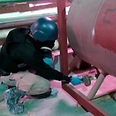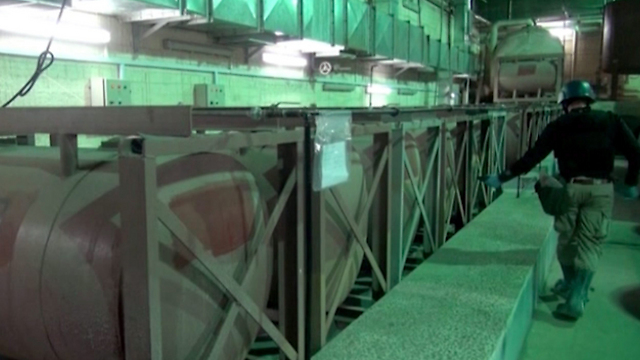
US, Russia see Syrian chemical disarmament overrunning
Leaked document reveals US, Russia want most chemical materials out of Syria by December, for remaining chemical weapons facilities to be destroyed by beginning of March
The document, a copy of which was seen by Reuters, calls for most chemical materials to be removed from the country in under eight weeks, by Dec. 31, and for remaining chemical weapons facilities to be destroyed by the beginning of March.
Related stories:
- US: Syria may try to hide chemical weapons
- Watchdog: Syria has destroyed chemical production facilities
- Report: Syria fully cooperative on chemical disarmament
Final destruction of all toxic material by the end of next year, as stated in the draft, would be six months beyond the date originally set for Syria to complete the "elimination" of all chemical weapons material. However, if that material were no longer inside Syria, governments seem unlikely to quibble.

Syrian chemical arms inspectors (Photo: EPA)
The timetable is part of an ambitious disarmament pact with the United Nations which President Bashar Assad accepted after an August sarin gas attack on the outskirts of Damascus killed hundreds and almost triggered US air strikes on Syria.
Washington and its allies blamed Assad, locked in a 2-1/2- year civil war, for the world's worst chemical attack in 25 years. Assad, supported by his ally Russia, accused rebels.
Weapons experts from the Organisation for the Prohibition of Chemical Weapons (OPCW) say they have already verified the destruction of chemical production and mixing equipment at 22 of the 23 sites declared by Syrian authorities in October.

Syrian chemical arms inspectors (Photo: EPA)
The organisation now faces a more challenging second phase of operations and is negotiating with Syria a detailed destruction plan for the chemical agents and remaining facilities, which must be agreed by next Friday, under the schedule set by the UN Security Council in late September.
Russia and the United States, which jointly brokered the original deal for Syria to destroy its stockpile of nerve agents and other toxic munitions by the end of June 2014, presented their draft timetable to the OPCW this week.
Under it, all chemicals should be out of Syria by Dec. 31, except for isopropanol - one of two main precursors for sarin - which should be destroyed on site by March 1. Unfilled chemical munitions should be destroyed by the end of January.
It also appears to reject a Syrian request to convert for peaceful use some of the facilities declared under its weapons programme, saying any facilities which were used for purposes prohibited by the international Chemical Weapons Convention should not be approved for conversion.
Dealine slips
The draft document calls on the OPCW and any countries which are prepared to receive the chemicals for elimination to submit a plan by mid-December setting out a destruction plan. It is still unclear where toxic material might go.
The document sets a 31 March, 2014, target for the most dangerous materials to be degraded "to chemicals not suitable for use in chemical weapons", followed by "completion of destruction not later than 30 December, 2014".
Though six months later than the target first set by Moscow and Washington for the complete elimination of all chemical weapons material and equipment, if they have indeed left Syria, any delay in the final destruction would reflect the complexity of the task, rather than the extent of Syria's cooperation.
Security Council Resolution 2118 obliges Syria to comply with a disarmament timetable laid out by the OPCW. The Hague-based agency made the end-June target for elimination "subject to" the detailed OPCW plan which is to be agreed by Nov. 15.
Moving material out may be the hardest part of the process.
Syria's civil war has killed 100,000 people, has no single frontline and has flared up across the country, cutting off or endangering main roads and supply lines linking major cities.
On Tuesday, the Foreign Policy website reported that Syria had presented the OPCW with a request for 40 armoured trucks and other equipment to help secure the road from Damascus to the Mediterranean coast and ship out the chemicals.
The plan also envisaged an advanced communications network linking Damascus to the sea, a route which has seen some of the heaviest fighting of the Syria conflict because it links Assad's capital to the mountain heartlands of his minority Alawite faith overlooking the Mediterranean.
While Assad's Western foes would be deeply reluctant to support - even indirectly - the consolidation of his military power over central Syria, they have few alternatives.
Flying dangerous shipments out of Damascus airport would be highly risky, while neighbouring Lebanon would also be a hazardous transit route for the chemical cargoes.
All the dates in the draft are in brackets, suggesting final agreement has not been reached. However, another section of the document reinforces the sense that the destruction of the chemicals will take more time.
If the OPCW or a country where the chemicals have been shipped believes it will not meet the deadlines for destruction "it may submit a proposal ... to revise the target date, specifying the circumstances and proposing an alternative target date, with a view to completing the destruction as soon as possible".
- Receive Ynetnews updates directly to your desktop










